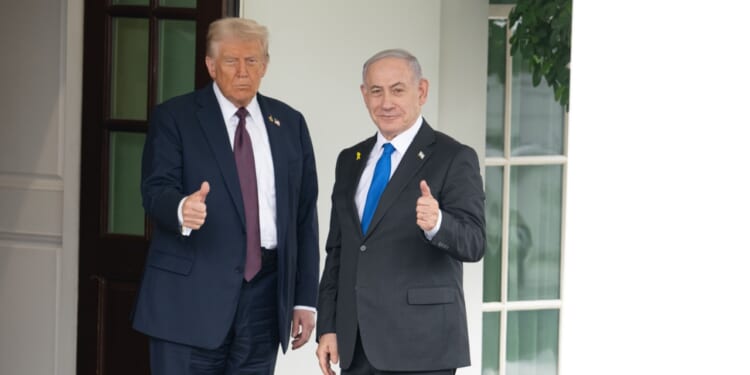One need look no further than Israeli prime minister Benjamin Netanyahu for the cause of the growing cracks in the Gaza ceasefire.
Not two weeks after the supposed “historic” signing of US president Donald Trump’s 20-point peace plan in Sharm el-Sheikh, Egypt, the initial stages of the agreement appear to be collapsing. While the effort freed detainees and hostages on both sides of the two-year Israel-Hamas conflict, Israeli prime minister Benjamin Netanyahu is working overtime to sabotage the agreement—just as he did with previous Gaza ceasefires. Just as in the past, that effort aims to perpetuate fighting in the Strip, with the goal of indefinitely extending Israeli control of Palestinian territory and Netanyahu’s own government.
To be clear, any ceasefire or broader peace agreement to a conflict of such magnitude and length as the Israel-Palestine one would necessarily experience numerous setbacks. Both Hamas and the Israeli government have interests that are informed by and inform their rivalry. Both advance those interests to strengthen their relative power and influence in the conflict. For example, just as Hamas is openly working to regain control over parts of Gaza that the Israel Defense Forces (IDF) withdrew from upon the signing of the 20-point plan, Israel continues to target supposed Hamas positions.
All violations of the ceasefire can and should be readily condemned. Guarantors of the deal are obligated to hold the parties accountable and are reportedly attempting to do so, at least to a degree. The question, however, remains the same as it has for decades —how will Washington handle Jerusalem’s brinkmanship? Thus far, Trump’s team is failing.
Since Hamas’ October 7, 2023, attack on Israel, the United States has aggressively defended Israel and continues to do so. However, Trump aggressively pushed his 20-point plan on both Israel and Hamas, clearly besting Netanyahu—someone who prides himself on influencing US politics. In this context, Trump’s overt and narcissistic desire to achieve quick policy “wins” proved to be more important than the American-Israeli diplomatic relationship. Trump’s interests come first, and one should never bet against the house.
To be clear, Trump remains one of the most pro-Israel presidents ever, if not the most, presiding over a strongly pro-Israel political base. That factor alone augurs poorly for his peace deal. Simply put, for the plan to succeed, the Trump administration will need to break out of its comfort zone by acting as the true senior partner in its relationship with Jerusalem.
That reality is why the current ceasefire is at risk of collapsing. While it appears to be true that Trump and his team are committed to seeing the peace plan through, sending high-level officials—including Vice President JD Vance—to Israel in a clear attempt to keep the Israelis within the confines of the agreement, such a push may require increasingly hostile and public professions of frustration with Netanyahu and the Israeli state. Is the Trump team prepared to cross certain lines that no Republican president has crossed in the past when it comes to Israel? Can it, or is it willing to, risk alienating its base—including its major pro-Israel funders like Miriam Adelson?
Already, US Secretary of State Marco Rubio plans to visit Israel this week, shortly after Vance’s visit alongside special envoy Steve Witkoff and Jared Kushner, Trump’s son-in-law and former advisor on Middle East issues. This degree of micromanagement suggests that the Trump administration has little faith that Netanyahu and the broader Israeli state are interested in abiding by the Gaza ceasefire, let alone Trump’s 20-point plan. At some point, something will have to give—either the ceasefire and peace plan or tensions between the American and Israeli camps.
That is not to say that the Trump team views Gaza or Palestinians and a future state of Palestine through a primarily humanitarian lens. Rather, the administration is committed to maintaining its diplomatic credibility, having expended massive political capital worldwide to garner support for this plan. Allowing Netanyahu to break the ceasefire—a move he may be more than willing to do even during the first phase of the peace plan—would be a serious embarrassment for the administration. Those who understand Trump’s politics and mindset know that this is an unacceptable outcome.
Yet, the ceasefire’s collapse already appears likely. Alongside Israel’s ongoing bombing of the Strip, it has violated its requirements on humanitarian aid. It continues to keep most crossings into Gaza closed and is restricting medical evacuations. Jerusalem has also planted spoilers, backing anti-Hamas militias within Gaza to fight the group.
This last component is critical to understand. Already, these militias played the role of inhibiting humanitarian aid to the Strip, ransacking aid convoys to further impoverish the famine-stricken Palestinians of Gaza in a blatant effort to pressure Hamas during ceasefire negotiations further. Now, Jerusalem may be using the militias to create a scenario in which Hamas will refuse to disarm—a primary component of Trump’s 20-point plan.
For Hamas, it would be madness to give up arms amid an ongoing Israeli occupation of half of Gaza’s land and competing Palestinian militias hellbent on replacing it as the singular power in the occupied territory. Equally dangerous to Trump’s plan, the ongoing clashes and a failure to disarm Hamas may cause states indicating an interest in sending troops into the Strip to constitute the “temporary International Stabilization Force,” as vaguely outlined in the plan, to have second thoughts—an evolving dynamic reportedly already at play.
Indeed, this card could be Israel’s ace in the hole. It can use the presence of these militias as a cudgel against Hamas, forcing the Palestinian faction to retain its arms in direct contravention of Trump’s plan. Jerusalem can concurrently claim that if no other state is willing to step in and secure Gaza, it will have to do so itself. If Netanyahu can achieve this, he will cite this violation and the failure to establish a stabilization force to garner Washington’s approval for renewed, full-scale military operations across Gaza and a perpetual Israeli military occupation.
That series of events would cement Israel’s forever war in the Strip, buying Netanyahu more time to survive the ongoing political crisis at home, threatening his political coalition, power, and freedom from incarceration amid ongoing corruption trials.
That effort, along with parallel ones designed to end the Gaza ceasefire, cannot be allowed to succeed. While Trump’s 20-point plan is a forever-occupation, pre-October 7 status quo pipedream ill-prepared to address the complexities of the Israel-Palestine conflict, a return to fighting cannot be allowed to continue under any circumstances. Recognizing the true spoiler in this dynamic—Netanyahu and the Israeli state—and acting accordingly can help prevent the worst possible outcome: a return to the US-backed, Israeli genocide of Palestinians in Gaza.
About the Author: Alexander Langlois
Alexander Langlois is a contributing fellow for Defense Priorities. Langlois holds a Master of Arts degree in International Affairs from American University, where he specialized in global governance, politics, and security. He is a foreign policy analyst and writer, with publications in various outlets, including The Carnegie Endowment for International Peace’s Sada, the Atlantic Council’s MENASource, the Lowy Institute, the Gulf International Forum, The New Arab, The Nation, Inkstick, and The National Interest.
Image: Noam Galai / Shutterstock.com.


















